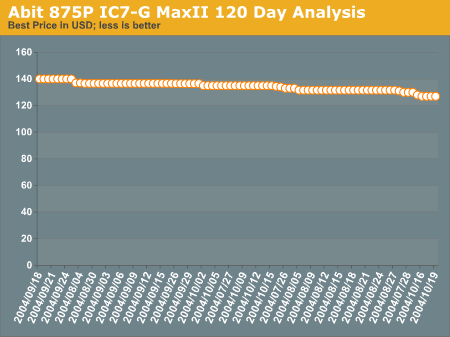Price Guides: CPU and Motherboards, October II, 2004 Edition
by Adam Rader on October 24, 2004 12:05 AM EST- Posted in
- Guides
Intel Motherboards - 8xx
With the big fanfare that surrounds DDR2, PCI Express and Intel's newest socket (all of this resulting in the platform that builds on the 9xx chipsets), it's not hard to forget that the 8xx series is far from dead just yet. Specifically, 875P tends to be the favorite among overclockers and stock performance seekers alike. This week, our recommendation goes to the Abit 875P IC7-G MaxII. This position would have been handed over to MSI for their Neo-FIS2r (875P as well) except for the pricing difference, which currently shows the Abit costing about $20 less than its MSI counterpart. While this isn't a massive price difference, it would put the cost noticeable over the $150 mark, at which it tends to become more difficult to justify a price increase.Both boards are amazing FSB overclockers and throw in all the extras, such as gigabit LAN (courtesy of Intel's CSA bus), SATA support, and plenty of connections for audio. In the end, however, price wins and Abit takes the position for this slot.











9 Comments
View All Comments
slurmsmackenzie - Monday, October 25, 2004 - link
what about 915 for 775? PCIe, ddr2 and ddr (4gb each), high definition audio. the asus p5gdc deluxe is an extremely versitile board than overclocks well all for 160 dollars. i just think it was awkward not to even mention the asus 915p and the gigabyte 915p lines. there are other options than the overpriced uncompromising 925 chipset.Rainman - Sunday, October 24, 2004 - link
For those who care, the Abit AA8 DuraMax has a $50 rebate on it making it only 102 dollars shipped from NewEgg.As usual, great work on the guide.
Gioron - Sunday, October 24, 2004 - link
I think #1 is talking about the wierd curves in between the yellow dots on the nforce2 motherboard graph on page 8. I'm not exactly sure whats going on in that graph either, and it probably wouldn't hurt to straighten all the blue lines.Other than that comment, I like the new format. Much more informative with the 120 day graphs and expanded comments. It looks like its a quite a bit more work than the previous style price guides, but it turned out well.
SUOrangeman - Sunday, October 24, 2004 - link
#1, I actually found the 120-day price analysis rather interesting. Perhaps they're worth keeping with the most dramatic changes are shown.FOr instance, there is no point in showing that data if only one vendor has product X and they never change the price. However, we may see some interesting supply-demand trends on products that are widely available (OK, more demand, than supply since it is widely available)
-SUO
AtaStrumf - Sunday, October 24, 2004 - link
I found this in your A64 pricing table:**9** Athlon 64 (939) 3200+ 512KB 90nm NewEgg 265.00 3.99 268.99 **110028** Check Prices
I think it need to be removed, since its doubled and makes no sense.
eetnoyer - Sunday, October 24, 2004 - link
Nice format. One thing to fix on pg.4 though..."One very nice attribute of the Sempron is that certain models make it very easy to adopt a newer socket 754 architecture without having to fork over the full cost of an Athlon XP..."
I think that should say Athlon 64
thebluesgnr - Sunday, October 24, 2004 - link
Very nice article, well done!Only thing missing is pricing on KT600/KT880 motherboards.
AnnoyedGrunt - Sunday, October 24, 2004 - link
What's up with Newegg and their almost $50 price increase on the 939 3200+At the current price, it really isn't a very good deal.
I haven't been that impressed with Newegg, and this price gouging certainly doesn't help their case.
Hopefully that price will come back down when the chip becomes more readily available.
-D'oh!
Chuckles - Sunday, October 24, 2004 - link
For future guides, would it be possible to eliminate the spline curves connecting the points? Right now they are a bit of a distraction, as they don't portray the local trends of the curves.Also the page 12 chart is showing the trend in price of the Abit IC7-G MaxII rather than the AA8 as recommended.